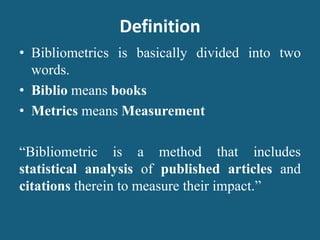BIBLIOMETRICS.pptx
- 1. BIBLIOMETRICS This work is licensed under a Creative Commons Attribution-Non Commercial-Share Alike 3.0 Un ported License 15-06-2023 1
- 2. 15-06-2023 2 Dr. Madhusudan Rao, Datrika MBA, MPhil, PhD, MSc(Psy), UGC-NET, APSET, PGDFTM, PGDIPR, DCA, MCIM(UK), Affi. CIPD(UK) Professor-Management in MR University for Women, Hyderabad. His M.Phil & PhD- area is “Consumer Behaviour”. His current research interests include Consumer Behaviour, and New-Age Marketing Practices. His teaching areas are Consumer Behaviour, Strategic Management, Marketing Research, Environmental Science, Gender Sensitization and IPRs. He has a blend of Teaching and Industry experience of 26 years. He had worked as an educator with different Government Universities and Ministries in Eritrea, Ethiopia and Bahrain for approximately 13 years. He has 9 articles and 4 books to his credit. He is Advisory/ Editorial Board Member of European Business & Management(USA), Intl. Journal of Business & Mgt (EU), Intl. Journal of Technology & Mgt Research, Ghana(West Africa), IJREM journal, Laescula Education; Member of British Council, MoE, Eritrea, Harvard Business School Publishing, and SHRM Consultants. He has won the Distinguished Educator Award 2019 by IBAE at Dubai; Best Senior Faculty Award 2019 by Novel Research Academy at Pondicherry; and a Memento by UNMEE. His Scholastic work is accessible here: http://ssrn.com/author-181609
- 3. Bibliometrics • It is the statistical analysis of bibliographics data commonly focused on citation analysis or research output publications. • Earlier the use of bibliometric methods were very frequently in the field of library and information science. Nowadays, it is trending in every domain. • It is used to provide quantitative analysis of academic literature. • Citational analysis is commonly used Bibliometric method which is based on constructing the citation graphs and networks. • Many research fields use Bibliometric methods to explore the impact of their fields.
- 4. Definition • Bibliometrics is basically divided into two words. • Biblio means books • Metrics means Measurement “Bibliometric is a method that includes statistical analysis of published articles and citations therein to measure their impact.”
- 5. Data • Web of Science, Scopus, Dimensions, and PubMed. Co-authorship networks, citation-based networks, and co-occurrence networks can be created based on data downloaded from Web of Science, Scopus, and Dimensions. Co-authorship networks and co- occurrence networks can also be created based on PubMed data. • Crossref, Europe PMC, and Microsoft Academic. Networks can also be created based on data retrieved through the APIs of Crossref, Europe PMC, and Microsoft Academic. These APIs can be queried interactively in VOSviewer. • Semantic Scholar, OpenCitations, and WikiData. For a given set of DOIs, networks can also be created based on data retrieved through the APIs of Semantic Scholar, OpenCitations, and WikiData
- 6. Visualization • Zooming and scrolling. Visualizations of bibliometric networks can be explored in full detail using zoom and scroll functionality similar to for instance Google Maps. A smart labeling algorithm prevents labels from overlapping each other. • Density and overlay visualizations. Density visualizations provide a quick overview of the main areas in a bibliometric network. Overlay visualizations can for instance be used to show developments over time. • Screenshots. Screenshots of bibliometric network visualizations can be created at a high resolution and can be saved in many popular graphical file formats, both bitmap and vector formats.
- 7. Techniques • Advanced layout and clustering techniques. State-of-the-art techniques for network layout and network clustering are provided. Layout and clustering results can be fine-tuned using various parameters. • Natural language processing techniques. Natural language processing techniques are available for creating term co-occurrence networks based on English-language textual data. Relevant and non-relevant terms can be distinguished algorithmically. • Creating bibliometric networks. A number of advanced features are available for creating bibliometric networks (e.g., co- authorship, bibliographic coupling, and co-citation networks). For instance, the influence of publications with many authors, many citations, or many references can be reduced using a fractional counting approach. Data cleaning can be performed using thesaurus files.
- 8. Advantages of Bibliometrics • Growth of literature • Growth of knowledge • It is straightforward method, since based on the simple counting, frequencies and descriptive. • On the first sight they are objective and unbiased. • Further directions for future researchers.
- 9. Advantages It could help in number of activities includes: • Demonstrate the importance and impact of your own research • Identify area of research strength and weakness • Identifying the top researchers in subject area. • Identify past, present and as well as forecast future publishing trends. • Study about the productivity of the institutions / individual and the disciplines. • Get quick publications in top tier journals.
- 10. Limitations of Bibliometrics • Citation patterns can differ greatly between disciplines. Only good sources are counted, therefore a large number of papers have been left unused. • Paper may be cited in negative rather than positive way, yet the citation would still be counted. • It does not include informal publications and communications. Therefore, the scientific development can not be predicted properly.
- 11. Sources of Bibliometric Data • SciVal • Scopus • Web of Science • PubMed
- 12. Some Computer Based Tools for Bibliometric Analysis • BibExcel • HisCite • VOS Viewer • Cite space • Citenet Explorer • Gephi • Pajek • Nvivo
- 15. Q & A madhu4m@gmail.com Cell: 09701877449 15-06-2023 15
- 16. Good luck Authors for your Quick publication of Articles! 15-06-2023 16
- 17. Next Webinars on • Digital Marketing • IPRs • Marketing Management • Consumer Behaviour • Strategic Management 15-06-2023 17

















